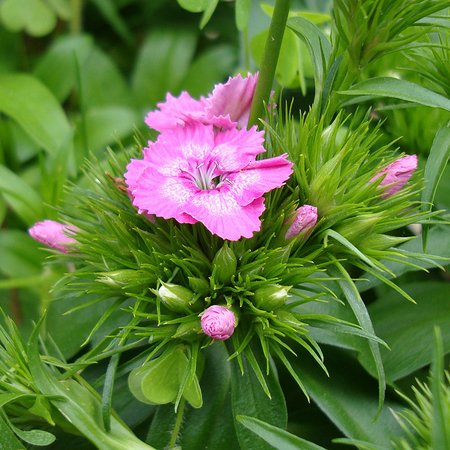Dianthus barbatus, commonly known as Sweet William, is a colorful, scented flower native to Southern Europe. Sweet William belongs to the family of carnations, and there are more than 300 species of this flower. Revered for centuries, the origins of this flower can be traced back to the Roman and Greek eras.
Sweet William is a biennial with flowers that bloom in the spring in clusters in varied hues of pink, red, crimson, violet, white, and scarlet. Sweet William leaves are tapered, while the stems grow up to 7-18 inches high, depending on its variety. The flowers are also used for wine flavoring in Spain and France.
Introduction to Sweet William and its Growing Conditions
Sweet William is a biennial plant with a two-year life cycle, producing only leaves in the first year. It looks a lot like carnations and can be grown from seeds, cuttings, or plant divisions.
If you’re planting them from seeds, plan on starting them indoors six to eight weeks before the last frost for spring blooms. The young seedlings generally transplant well and can be set outdoors after the last frost. Seeds, sown in the first year, bloom in the spring of the second year.
Sweet William flowers are 2-3 cm in diameter and have five petals with serrated edges. Although red flowers with a white base are most common, other varieties include pink, violet, and white to variegated patterns. The flowers are also vibrant and fragrant, making them perfect for decorating a rock garden, walled garden, or simple borders in gardens.

Planting Sweet William Seeds
Sweet William (Dianthus barbatus) can be bought as small plants or plugs, or grown from seeds. The best time to sow the seeds is in May-July. These plants will bear flowers next year.
Some varieties like the Sweet Pink Magic or the Sweet Purple White Bicolor can flower the same year they’re planted if the seeds are sown in a heated propagator from January to March and transplanted in April or May.

When to Plant Sweet William Seeds
Sweet William can be easily propagated via tip cutting, from seed, and by division. Plants available at nurseries are typically one year old and will flower in the year they’re planted.
Sow the seeds indoors 2-8 weeks before your area receives the last frost. Sprinkle them onto well-watered seed compost in a seed tray. Cover very lightly and place the tray in an ambient position out of the full sun: these seeds germinate best in temperatures of 64°F-68°F (17°C-19°C) (avoid fierce heat).
If you are planting the seeds directly outdoors, sow them at a depth of ⅛ inch once the frost has passed. Seeds typically take 10-15 days to germinate, while the flowers bloom in the spring.
Ideally, Sweet William should be planted in areas with full sun; however, they can tolerate light or partial shade. Be sure to plant them in a place where they receive up to 5 hours of sunlight every day.
Type of Soil
Sweet William plants prefer rich, fertile, well-drained, and mildly alkaline (pH 6.75) soil. Adding organic fertilizerat the time of planting helps these plants grow healthier and stronger. Once the Sweet William plant has 3-5 leaves, thin them about 8-12 inches apart. Remember to weed your plants regularly.
Applying a layer of mulch can also help with moisture retention and improve air circulation. So make sure you layer the soil with about 2-3 inches of mulch.

Water Requirements
Sweet William should be watered once or twice a week as it cannot bear overwatering. Be sure to keep the soil moist. Uninterrupted air circulation around the stems also ensures optimal plant growth.
Harvesting and Saving Sweet William Seeds
Cut long stems of recently opened flowers and place them immediately in water for sweet-scented, fresh flowers.
Regular deadheading is essential to keep Sweet Williams blooming. Deadhead any spent Sweet William flowers and cut the stem to half its height once all the flowers on it have gone over.
However, if you want these plants to reseed and grow in the next season, stop beheading the flowers towards the end of summer and let the seeds mature. The seed pods will turn brown and split open once they ripen.
You can allow these black disc-shaped seeds to fall to the ground to spread on their own, or remove the seeds by shaking the pods over a container. Store these seeds in a cool, dry place to plant them in pots or in other parts of the garden.
Sweet Williams Care
Sweet William plants are easy to grow when provided with optimal growing conditions. However, it’s vital to keep the following considerations in mind:
- Waterlogging or planting in poorly drained soil can promote fungal diseases like crown rot and rust in these plants. Take care not to overwater.
- Make sure the soil is moist but not saturated.
- This relatively cold-hardy plant can survive light frosts, but cannot survive in deep freezes. Also, high humidity and temperatures over 85 degrees Fahrenheit can result in dormancy.
- Apply organic fertilizer every 6 to 8 weeks.
- Cut back dead blooms after flowering to protect your plants from the winter, but avoid pruning in the fall.
- Allow the dead foliage to fall to the ground to form a layer of protective mulch. Insulate the roots by adding a few more inches of mulch.
- If you have planted Sweet William in pots outside, move these containers away from areas that suffer from ice, wind, and snow.
Troubleshooting Common Sweet William Problems
Although Sweet William shows better disease resistance compared to other plants, it can still face the following problems:
- Pests: Spider mites, aphids, slugs, and snails can be a problem for Sweet Williams. You can take care of aphids by blasting them with water from the hose. Creating a sharp sand ring around the plant also help keep snails and slugs away.
- Fungal diseases: Sweet William plants are also susceptible to fungal diseases like rust and crown rot that are typically caused by poorly drained soils. Keeping the crowns slightly above the soil line and ensuring free-draining soil helps in the prevention of these diseases.

Secrets of success
Noteworthy characteristics: Various cultivars produce colorful and disc-like blossoms, which are decoratively fringed and intensely fragrant. They are equally stunning as single colors, bicolors, or in a mixed palette.
Soil type: Clay, loam, sand, silt.
Light: Sweet Williams prefer full sun, but will tolerate light shade.
Care: Grow in fertile, moist but well drained soil in full sun. Needs low watering.
Propagation: Sow seed of biennials in summer; plants will bloom the following year.
Attracts: Butterflies, hummingbirds, visual attention.
Problems: Crown rot, slugs, sow bugs, grasshoppers, chipmunks, squirrels, deer.

Final Thoughts
Sweet Williams (Dianthus barbatus) are quite popular among gardeners due to their pink, violet, red, or white blossoms and fragrant leaves. It’s ideal for use in perennial beds, containers, and cottage gardens, and attracts pollinators like bees, butterflies, and hummingbirds.
But despite being fairly easy to grow, these plants can encounter a few pests and diseases. However, providing favorable growing conditions like moderate moisture and fertile, well-draining soil ensures its health.
Seedlings planted in late spring will typically produce flowers the next year; however, some new cultivars may bloom in the first year if the seeds are planted early. According to research, Sweet William is mildly toxic to people and pets.




